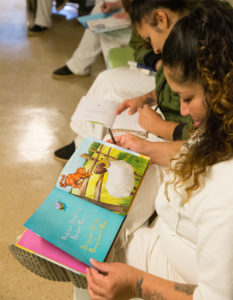
For My Kids by Melissa Bigstone
It seemed like a normal day, woke up got ready and I was on my way,
But little did I know that all would be lost,
I was hoping and praying I could go back in the past,
Wishing it didn’t happen so fast,
Now all I can do is wait, and do my best to fight this fate,
Wondering why this happened to me!
Is there something I didn’t, see?
I know some day this will grow on me,
I just got to move on and hope to see,
I know now that the best things in life don’t come for free,
I hope that this will all end soon by the time spring comes and the flowers are ready to bloom,
I want to do it right next time, I do not wanna miss no warning signs,
’Cause I wake up every day not knowing what to say,
Just thinking about that one day I woke up thinking it was an ordinary day.…
Women’s Storybook Project of Texas is committed to being a resource for incarcerated mothers spending time away from their children. Our program provides hope and a chance for a child to reconnect with their mother through recorded stories.
Here is a list of 20 issues within prison systems. Though some reforms have been made, many women and their children experience harm and difficulties due to the lack of policy, reform, resources, and rehabilitation.
- Many individuals who are incarcerated are without access to psychological counseling, treatment for addiction, or vocational training.
- According to a national survey, 73% of women in state prisons as compared to 55 % of male adults in state prisons exhibited mental health issues.
- The percentage of women in prison has increased every year since the 2000s, according to the institute on Women & Criminal Justice Report “Hard Hit: The Growth in the
Imprisonment of Women.”
- Almost two and a half million children in America have a parent in prison.
- Women within the larger prison system, women, and their children, are neglected and seen as invisible. It is more likely for both women and girls to fall into one or more of the following categories than their male counterparts: low-income, unemployed,
underemployed, limited literacy and educational levels, juveniles; alcohol and drug addicts, people with backgrounds of sexual, emotional, or physical abuse; mentally ill.
- Most women’s violent crimes involve simple and aggravated assault despite media coverage and stereotypes.
- Violent offenses by women are often committed against family members or intimates in domestic settings.
- Most mothers in prison devote their time trying to sustain some form of contact with their children, even when they have lost all custody. Painful emotional struggles surround such efforts, from the remote locations of most prisons to the depressing limitations of mother–child visits and high cost of telephone calls are all crucial facets of women’s incarceration.
- Everyone has a right to accessible healthcare; however, studies have shown that those who are incarcerated have poor access to healthcare within the prison.
- Women who are incarcerated have been reported being seen as “sub-human” and have described stigma and fear as barriers to their community healthcare engagement.
- Many women enter the Criminal Justice System with untreated and undiagnosed mental health problems because mental health services are difficult to access in lower-income communities.
- There is a need for specialty care in prisons, especially health care providers who are empathetic and compassionate. “Health care providers need to believe, listen to, and take the needs of the women in prison seriously.”
- African American and Latina women make up more than 60 percent of women locked up in state and federal prisons.
- More than 33% of women in the prison system identify as LGBTQ.
- LGBTQ prisoners struggle to access gender-affirming medical care, appropriate clothing, and personal hygiene supplies, leading to further humiliation and shame.
- LGBTQ individuals face more victimization while incarcerated.
- Police bias and anti-trans laws contribute to high rates of incarceration, particularly for trans women of color. They report being arrested even when they were victims of violence because police did not take their complaints seriously.
- One in five transgender women reports some level of physical or sexual assault while being incarcerated.
- Section 115 of the Welfare Reform Act affects more than 90,000 women in 42 states. This act inhibits individuals who have drug offenses from being banned from welfare
benefits and food stamps post-incarceration. Offenders released from prison who have committed murder, for example, are eligible for welfare and food stamps, but not those who have a conviction for possession or selling small quantities of drugs.
- The Welfare Reform Act currently places over 135,000 children at risk of neglect and involvement with the criminal justice system due to the prospect of discontinued family reduced income support.
References
Arditti, and Few, A. L. (2006). Mothers’ Reentry into Family Life Following Incarceration. Criminal Justice Policy Review, 17(1), 103–123. https://doi.org/10.1177/0887403405282450
Barrett, Jacob. “LGBTQ Adults and Youth Face Criminalization and Over – Incarceration.” Prison and Legal News. Nov. 2022, https://www.prisonlegalnews.org/news/2022/nov/30/lgbtq-adults-and-youth-face-criminalization-and-over-incarceration/
National Resource Center on Justice Involved Women Fact Sheet on Justice Involved Women in 2016.
Norris, Whitney K., et al. “‘You’re setting a lot of people up for failure’: what formerly incarcerated women would tell healthcare decision makers.” Health & Justice, vol. 10, no. 1, 1 Feb. 2022, p. NA. Gale Academic OneFile, link.gale.com/apps/doc/A691388938/AONE?u=txshracd2555&sid=bookmark-AONE&xid=f8a5b88b. Accessed 15 Jan. 2023.
Minaker, Joanne. Criminalized Mothers, Criminalizing Mothering, Demeter Press, 2015. ProQuest Ebook Central, http://ebookcentral.proquest.com/lib/stedwards/detail.action?docID=6151267.
Created from stedwards on 2023-01-15 05:47:49.
Talvi, Silja J. A.. Women Behind Bars: The Crisis of Women in the U.S. Prison System, Seal Press, 2007. ProQuest Ebook Central, http://ebookcentral.proquest.com/lib/stedwards/detail.action?docID=680028.

